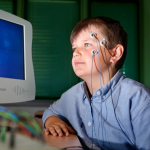
Attention Deficit Hyperactivity Disorder (ADHD) is a neurodevelopmental disorder characterised by persistent inattention and/or impulsivity and hyperactivity.
Neurofeedback is an intervention designed to reduce altered patterns of brain activity that are apparent in childhood ADHD (e.g. Snyder & Hal, 2006). Electroencephalography (EEG) is a technique for measuring neurophysiological activity on the scalp. Activity in a certain brain region or frequency band, that is associated with ADHD symptomology, is then computed into visual displays or acoustic signals in real time. For example, brain activity may be represented by the height of a ball on a screen; as activity fluctuates so does the height of the ball and the individual begins to learn how to control this activity.
In this recent report, Cortese and colleagues (2016) present a meta-analysis of Randomised Controlled Trials (RCTs) for childhood ADHD.

Neurofeedback is a type of biofeedback that uses real-time displays of brain activity (commonly EEG), to teach self-regulation of brain function.
Methods
The authors implemented a broad search strategy to identify published RCTs of children with ADHD aged 3-18 years.
Studies were included if they measured severity of ADHD symptoms using rating scales and/or performance on neuropsychological tasks, such as attention and inhibition. Studies were included if the participants were diagnosed with any ADHD subtype, or scores in accepted cut-offs of validated ADHD rating scales. Children with rare comorbid disorders were excluded.
Study bias was assessed using the Cochrane Risk of Bias tool and the protocol for the meta-analysis was pre-registered to allow for transparency in any methodological amendments.
Treatment as usual, active and sham were acceptable control groups; however, active and sham controls were considered more rigorous. In a sham control participants complete the same training programme but receive random feedback, and in an active control participants complete a different training programme (e.g. cognitive training or biofeedback from muscle tension).
As regards blinding, the authors also made a distinction between ‘probably blinded’ and ‘most proximal’ assessments of ADHD symptoms. Probably blinded assessments were completed by individuals who were unlikely to be aware of the treatment conditions (typically teachers) and most proximal assessments were completed by individuals who were likely to aware of the treatment conditions (typically parents). Awareness of the treatment condition can lead to biases in the way someone responds to or evaluates the treatment.
Finally, the studies were also assessed on whether they used a standard methodology.
Results
- 13 RCTs were included in the analyses
- Across all trials, neurofeedback significantly reduced ADHD symptoms as rated by most proximal individuals
- This effect was also significant for studies that used a standard neurofeedback protocol
- In studies employing an active or sham control, neurofeedback significantly reduced hyperactivity/impulsivity symptoms
- However, neurofeedback had no significant effect on ADHD symptoms when rated by individuals who were probably blind
- And there was no effect on neuropsychological assessments of attention and inhibition
Conclusions
The effect of neurofeedback on ADHD symptoms depended on whether assessments were completed by most proximal or probably blinded individuals. The authors concluded that this provides insufficient evidence for the efficacy of neurofeedback because most proximal individuals may be prone to bias.

Probably blinded trials fail to show neurofeedback as an effective treatment for ADHD.
Strengths and limitations
The meta-analytic approach is a major strength of this report because it considers all the available data from RCTs, which provide the highest quality of evidence. In their analyses, the authors also make important distinctions between the reliability of ADHD assessments, suitability of control groups and quality of the neurofeedback procedure.
A limitation of the methodology was the categorisation of effective treatments, such as cognitive training, as appropriate control groups. This approach is likely to underestimate the effects of neurofeedback. Sham neurofeedback is a more appropriate control because it is inert but otherwise identical, which should account for bias and validate assessments of ADHD symptoms by most proximal individuals.
Interestingly, neurofeedback significantly reduced hyperactivity/impulsivity symptoms in studies with sham and active controls, which should induce comparable expectations of improvement to neurofeedback. Yet this effect was absent for assessments by probably blinded individuals. This suggests that risk of bias may not be the only important difference between the assessors, who were mostly parents or teachers. Indeed, parents will often observe the child in numerous different contexts whereas teachers will observe the child in a structured environment amongst a class of other children. Therefore, parents may be more sensitive to observing change.
The authors also noted a number of limitations associated with the RCTs analysed. This includes: an absence of manipulation checks in most studies, no analysis of the mediating effect of neural change, inconsistency in the neurofeedback protocol, a lack of statements of potential conflicts of interest and the methodological rigour was generally unclear. Furthermore, there was a lack of studies examining long-term ADHD outcomes and other important outcomes, such as working memory and academic achievement.
Summary
- The findings from this meta-analysis suggest that neurofeedback cannot currently be recommended as a treatment for children with ADHD.
- Future research should investigate the mechanisms of neurofeedback, factors that predict treatment response, long-term outcomes and implement standard neurofeedback protocols and sham control groups.

Better research is needed before we can start to consider neurofeedback as a treatment for children with ADHD.
Links
Primary paper
Cortese S, Ferrin M, Brandeis D et al. (2016) Neurofeedback for Attention-Deficit/Hyperactivity Disorder: Meta-Analysis of Clinical and Neuropsychological Outcomes From Randomized Controlled Trials, Journal of the American Academy of Child & Adolescent Psychiatry, Volume 55, Issue 6, June 2016, Pages 444-455, ISSN 0890-8567. http://dx.doi.org/10.1016/j.jaac.2016.03.007.
Other references
Snyder SM, Hall JR. (2006) A meta-analysis of quantitative EEG power associated with attention-deficit hyperactivity disorder. Journal of Clinical Neurophysiology, 23(5), 441-456. [PubMed abstract]

Neurofeedback for ADHD in children https://t.co/GbImyk6e6G #MentalHealth https://t.co/zOsfHoMZWa
Today @PsyJoff on meta-analysis of #neurofeedback for #ADHD https://t.co/i0NHnGK7ck
“Probably blinded trials” fail to show #neurofeedback as an effective treatment for ADHD https://t.co/i0NHnGK7ck #MetaAnalysis
Neurofeedback for #ADHD in #children https://t.co/fNzsQSJ883 #Evidence from a #metaanalysis from @Mental_Elf
El neurofeedback no parece un tratamiento efectivo para el TDAH en estudios con evaluadores ciegos a la intervención https://t.co/YlIcXKaeoo
“Neurofeedback for ADHD in children” evidence still not strong enough. https://t.co/G2bA0qWOF7
Better research is needed before we can start to consider neurofeedback as a treatment for children with ADHD https://t.co/i0NHnGK7ck
The lead author is a paid consultant of several drug companies – that speaks volumes “Dr. Holtmann has served in an advisory or consultancy
role for Medice and Shire, and has received conference attendance support or was paid for public
speaking by Eli Lilly and Co., Medice, Neuroconn, and Shire. Dr. Daley has provided educational
talks for Eli Lilly and Co. and Shire, has attended an advisory board for Eli Lilly and Co., has
received support for educational travel from Eli Lilly and Co., Shire, and HP Pharma, and research
funding from Shire”
Neurofeedback for ADHD in children https://t.co/qRZbeODmsm via @sharethis
Don’t miss: #Neurofeedback for #ADHD in children https://t.co/i0NHnGK7ck #EBP
[…] Neurofeedback for ADHD in children […]
[…] blogged last year about a meta-analysis of neurofeedback for ADHD in children, which concluded that neurofeedback cannot currently be recommended as a treatment for children […]